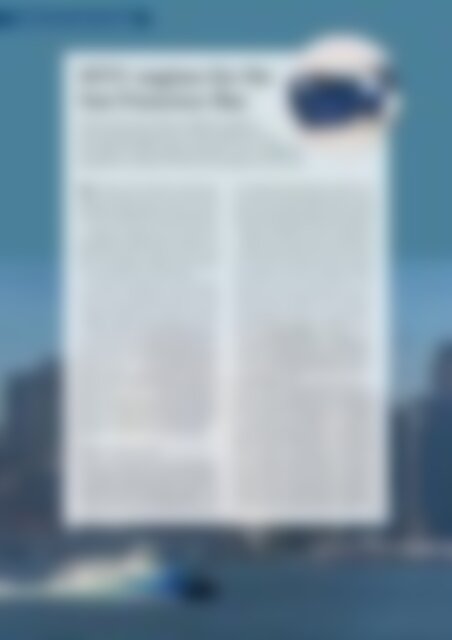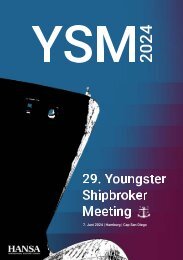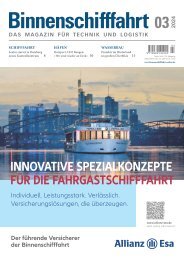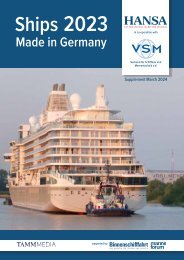HANSA 10-2017
Fährschifffahrt | Brexit | HIPER | Schifffahrt der Zukunft | Börsenbericht | US Ports & Hurricanes | Abwasser | Häfen Niedersachsen | HVAC | Job-Börse | Offshore-Marktkompass
Fährschifffahrt | Brexit | HIPER | Schifffahrt der Zukunft | Börsenbericht | US Ports & Hurricanes | Abwasser | Häfen Niedersachsen | HVAC | Job-Börse | Offshore-Marktkompass
Erfolgreiche ePaper selbst erstellen
Machen Sie aus Ihren PDF Publikationen ein blätterbares Flipbook mit unserer einzigartigen Google optimierten e-Paper Software.
Schiffstechnik | Ship Technology<br />
MTU engines for the<br />
San Francisco Bay<br />
The San Francisco Bay is subject to special<br />
environ mental protection. Now MTU has won<br />
the order for delivering its first EPA Tier 4-compliant<br />
propulsion systems for ferries that operate in the area<br />
The egines will be installed in three brandnew<br />
catamaran ferries for WETA (Water<br />
Emergency Transportation Authority). The first<br />
of the three high-speed ferries is expected to enter<br />
service on the San Francisco Bay in late 2018.<br />
»Our goal is to operate a ferry service that is<br />
sustainable, cost-effcient and eco-friendly,« says<br />
Nina Rannells, WETA Executive Director. »The<br />
MTU Tier 4 engines will play a critical role in<br />
WETA’s expansion of sustainable and reliable<br />
ferry service on the San Francisco Bay.«<br />
For the three 44-m catamarans, MTU is to supply<br />
in total six 16V 4000 units, six MTU-built SCR<br />
systems and six ZF gearboxes. All three vessels<br />
will also be equipped with MTU BlueVision ship<br />
automation. Each engine will deliver 2,560 kW/<br />
3,435 bhp (1,800 rpm), enabling the catamarans<br />
to reach speeds up to 34 kn. The ferries are being<br />
built by the Dakota Creek Industries shipyard,<br />
and since they are destined for service in<br />
the Bay of San Francisco, the engines that propel<br />
them will be subject to the EPA Tier 4 emissions<br />
standard which came into force in the US on<br />
1 January 2016. This demands substantially lower<br />
nitrous oxide, particulate and hydrocarbon emissions<br />
compared with the previous emissions stage.<br />
»The system solution that MTU offers satisfies all<br />
our criteria with respect to emissions, space requirement<br />
and performance,« says Rannells.<br />
20 years of partnership<br />
The MTU-San Francisco Bay Area ferry partnership<br />
goes back to 1997 and its development<br />
was strongly supported by the MTU distributor<br />
Pacific Power Group. WETA now operates over<br />
30 MTU engines – Series 2000 or 4000 – in its<br />
passenger only ferries. Knut Müller, head of marine<br />
and governmental business at MTU, says:<br />
»We are immensely proud that WETA has selected<br />
our Tier 4 engines. WETA has always sought<br />
drive technology of the highest order in terms of<br />
innovation and ecological soundness and that has<br />
constantly challenged us to keep on developing.«<br />
WETA’s current ferry fleet is comprised of<br />
14 high-speed catamarans that provide service<br />
via nine terminals between the cities of Vallejo,<br />
San Francisco, Alameda, Oakland and South<br />
San Francisco. Since 2012, passenger numbers<br />
have grown by 78% and now reach the 2.7 million<br />
mark. The ferries are deployed to relieve the<br />
traffc on Bay Area bridges. »We are experiencing<br />
unprecedented growth in ferry ridership,«<br />
says Rannells. »As our Bay Area population expands<br />
and traffc congestion continues to worsen,<br />
more and more people are looking for a convenient<br />
and enjoyable means of transportation,<br />
and they’re turning to ferries.« In 2016, WETA<br />
adopted a strategic plan that outlines a vision for<br />
44 vessels, 16 terminals and a 740% increase in<br />
peak capacity by 2035.<br />
Scheduled for delivery to WETA at the end of<br />
this year is MTU’s propulsion system as launched<br />
in 2016, which integrates Series 4000 diesel engines<br />
with SCR systems for exhaust gas after-treatment<br />
for compliance with the IMO III and EPA Tier<br />
4 emissions standards. Advances in turbocharging,<br />
internal combustion and fuel injection, combined<br />
with the new SCR system, have facilitated<br />
a 75% reduction in nitrous-oxide emissions compared<br />
to IMO II and a 65% reduction in particulates<br />
compared to EPA Tier 3. There is no need for<br />
an additional diesel particulate filter, and fuel consumption<br />
is up to 5% lower than on the predecessor<br />
engine. Depending on the number of cylinders,<br />
power output ranges from 1,380 to 3,220 kW. M<br />
Photos: MTU<br />
52 <strong>HANSA</strong> International Maritime Journal – 154. Jahrgang – <strong>2017</strong> – Nr. <strong>10</strong>


















